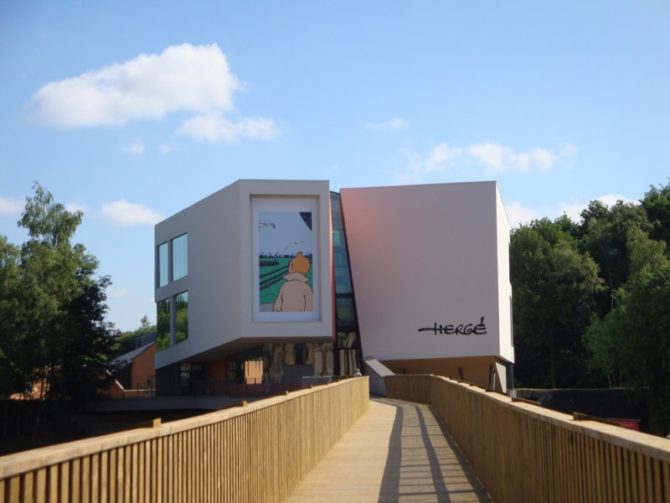Belgium: New Museums for Magritte and Hergé

Belgium
Surrealist painter René Magritte and cartoonist Georges Rémi, known as Hergé, two of Belgium’s most important, popular and influential 20th-century artists, are both getting their own one-man museums this week, opening to the public simultaneously on June 2, 2009.
Magritte (1898-1964), the dapper suburban bourgeois gentleman who always dressed in suit and tie, even when painting, had an unbridled imagination and a wicked sense of humor, both of which he exercised in simple, flat paintings of ordinary people and objects shockingly juxtaposed, often full of ominous portent and mystery, but, he always insisted, totally devoid of any significance other than “visual poetry”.
Installed in a neo-classical 19th-century building on the Place Royale in Brussels, the new museum is part of the adjacent Belgian Royal Museums of Fine Arts and offers some 250 paintings, drawings, graphic works, films and memorabilia-the largest collection of the artist’s work in the world, including the collection owned by the Royal Museums and works from other museums and private collectors on long-term loans.
Presented in chronological order on three floors, the permanent collection covers the artists long career, from the early paintings experimenting with various styles to his discovery of Giorgio de Chirico and the Paris Surrealists, the graphic advertising work he did to earn his living and the gradual development of the visual vocabulary that defined his maturity-green apples, spherical bells, birds, puffy white clouds in a blue sky, floating rocks, men in bowler hats (probably inspired by the bowler-hatted detectives in a French silent-movie series who pursue the arch-criminal Fantomas) and the curving wooden pipe made famous in his Surrealist icon, with the words Ceci n’est pas une pipe-This is not a pipe-written beneath it in careful cursive script.
All the explanatory information presented on the museum’s walls is provided in French, Flemish/Dutch and English.
Musée Magritte Museum 1 Place Royale, Brussels (ticket office 3 rue de la Régence). +32.2.508.32.11. website
Tintin and Company
Like his near-contemporary Magritte, Hergé (the initials of Georges Rémi, in reverse order, as pronounced in French, err-zhay) was also born in Brussels. He created his best-known and internationally beloved character, Tintin the boy reporter, in 1929, when his earliest cartoons were published in Le Petit Vingtième, the children’s Sunday supplement to a local newspaper. Since then Tintin’s adventures, from the Soviet Union to the Himalayas and the Arctic ocean, have filled more than 20 albums and been published in more than 80 languages, selling more than 230 million copies worldwide.
But even visitors who know little of Tintin can’t help but be seduced by his delightful world, as presented in the terrific new museum designed by Pritzker-prize-winning French architect Christian de Portzamparc in Louvain-la-Neuve, a new university town 20 miles southeast of Brussels. Portzamparc grew up with the Tintin books, and he says that his first childhood drawings were of Captain Haddock, the grizzled sea captain who animates the Tintin tales along with faithful dog Milou (Snowy in English), his Chinese friend Chang, the bowler-hatted detectives Dupond and Dupont (Thomson and Thompson in English) and the Italian diva Bianca Castafiore.
Portzamparc obviously has great affinity, and affection, for Tintin and Co, and it shows in his joyous, exuberant building, a white “prism” set slightly askew on stilts at the edge of a wooded park, with big windows like cartoon-panel frames and an interior inspired by the seaports, schooners, junks and cargo steamers in Tintin’s travels. The vast lobby is an atrium, flooded with light from glass walls and skylights, housing big structures in odd shapes and pastel colors-pale yellow, coral, lilac, sky blue-and an elevator column in a navy blue and white checkerboard pattern reminiscent of the red-and-white checkerboard of the rocket ship that takes Tintin to the moon.
The big interior structures, connected by gangways, contain eight galleries in which the museum’s permanent collection will be shown-80 original plates and more than 800 drawings, photographs, posters, figurines, toy replicas and other objects, not only of Tintin and his friends but of other Hergé characters and his other graphic work, including advertising posters. Because they cannot be exposed to light for long periods of time, the works on paper displayed will rotate every four months.
The privately owned, €18-million museum was conceived and funded by Hergé’s second wife, now Fanny Rodwell.
Musée Hergé 26 rue du Labrador, Louvain-la-Neuve. +32.(0)10.488.421. See More Musée Hergé, See More Tintin
Share to: Facebook Twitter LinkedIn Email
Leave a reply
Your email address will not be published. Required fields are marked *



